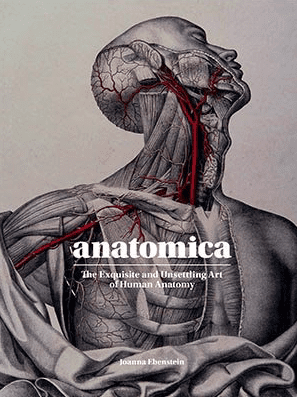Arpan K. Banerjee
Solihull, United Kingdom

The first known anatomy book was written around 300 BC by Diocles, a Greek philosopher and physician who based his work on animal dissections. Andreas Vesalius’ De Humani corpori Fabrica from 1543 was the first major work based on dissections of human cadavers. It dispelled many myths and challenged the supremacy of Galenic teachings, which had survived unchallenged for hundreds of years.
Over centuries, the study of anatomy became an important part of doctors’ training. Anatomy lecture theaters proliferated, beginning in Padua in 1594, and more texts were produced, including Henry Gray’s 1858 Anatomy: Descriptive and Surgical, Anatomy of the Human Body, known today simply as Gray’s Anatomy.
Joanna Ebenstein, the author of Anatomica, is an independent scholar, curator, and photographer with an interest in morbid anatomy. This unusual book contains anatomical images and illustrations that include corpses, dissections, and écorches (flayed figures with the skin removed, considered to be works of art in the seventeenth and eighteenth centuries). The images span several centuries, derive from a variety of sources, and are well-annotated. Woodcuts and watercolor images of beautifully performed dissections highlight the remarkable skills of artists from yesteryear, and the illustrations, engravings, lithographs, and other art forms from Europe and Asia emphasize the international interest in anatomy.
Individual book sections focus on the full body, the dissected body, and specific anatomical systems. The author shares her extensive research in succinct summaries of the origins of these magnificent studies. The timeline at the beginning of the book is particularly useful to understand and contextualize major advances in the study of anatomy over the centuries.
Fascination with anatomy and the production of anatomical images is not new. Artists have illustrated medical texts for centuries with remarkable skill. Entire museums are dedicated to the topic, such as the Josephinum Medical Museum in Vienna, where wax models of dissections made in Florence in the 1780’s are displayed for the public. German anatomist Gunther Von Hagens, inventor of the plastination technique, has toured the world with his Body Worlds exhibit, a collection of dissected bodies that has been popular as well as controversial. Anatomica adds to our knowledge and fascination with this topic by combining superb, high-quality images with an exploration of the cultural interface between human anatomy, death, and depiction of the dissected body as an art form.
Anatomica: The Exquisite and Unsettling Art of Human Anatomy
Joanna Ebenstein
Lawrence King Publishing, 2020
ISBN 9781786275714
ARPAN K. BANERJEE, MBBS (LOND), FRCP, FRCR, FBIR, qualified in medicine at St. Thomas’s Hospital Medical School, London. He was a consultant radiologist in Birmingham from 1995–2019. He served on the scientific committee of the Royal College of Radiologists 2012–2016. He was Chairman of the British Society for the History of Radiology from 2012–2017. He is Treasurer of ISHRAD and adviser to Radiopaedia. He is the author/co-author of numerous papers and articles on a variety of clinical medical, radiological, and medical historical topics and seven books, including Classic Papers in Modern Diagnostic Radiology (2005) and The History of Radiology (OUP 2013).

Leave a Reply